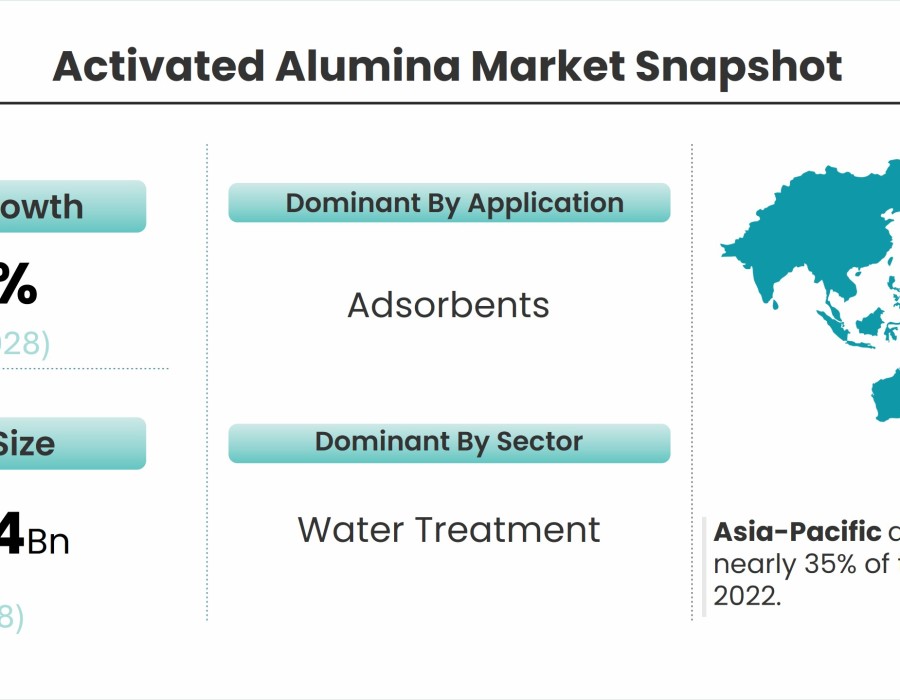According to Stratview Research, the activated alumina market was estimated at USD 0.97 billion in 2022 and is likely to grow at a CAGR of 5.6% during 2023-2028 to reach USD 1.34 billion in 2028.
Activated alumina, a highly porous form of aluminum oxide, has emerged as a versatile and indispensable material with a wide range of applications across various industries. From water treatment to gas purification, catalysts, and beyond, activated alumina plays a critical role in enhancing efficiency, performance, and sustainability. In this article, we delve into the opportunities inherent in the activated alumina market, shedding light on its diverse applications, market dynamics, and growth prospects.
The Essence of Activated Alumina
Activated alumina is a porous, granular material derived from the dehydration of aluminum hydroxide. Through a process of activation, typically involving high-temperature heating, the material develops a highly porous structure with a large surface area, giving it exceptional adsorption properties. This unique structure enables activated alumina to effectively remove impurities, contaminants, and moisture from various substances, making it a valuable material in numerous industrial processes.
Water Treatment and Desiccation
One of the primary applications of activated alumina is in water treatment, where it is used for the removal of fluoride, arsenic, and other contaminants from drinking water. Activated alumina's high surface area and adsorption capacity make it an ideal medium for adsorbing fluoride ions, thereby improving water quality and safety. Additionally, activated alumina is widely used as a desiccant in air and gas drying applications, where it effectively removes moisture to prevent corrosion and degradation of sensitive equipment and materials.
Catalysis and Chemical Processing
Activated alumina serves as a catalyst support in various chemical processes, including the production of petrochemicals, fertilizers, and polymers. Catalysts supported on activated alumina offer enhanced surface area and reactivity, facilitating efficient conversion of reactants into desired products while minimizing unwanted byproducts. Additionally, activated alumina-based catalysts are employed in processes such as hydrogenation, dehydration, and adsorption, enabling precise control over reaction conditions and product quality.
Gas Purification and Adsorption
In gas purification applications, activated alumina is utilized for the removal of impurities such as moisture, hydrogen sulfide, and volatile organic compounds (VOCs) from air and gases. Activated alumina's high adsorption capacity and selectivity make it an effective medium for gas purification, ensuring compliance with stringent environmental regulations and industry standards. Moreover, activated alumina-based adsorbents are employed in air separation processes, pressure swing adsorption (PSA) systems, and gas chromatography applications, among others.
Market Dynamics and Growth Prospects
The activated alumina market is driven by several key factors, including increasing demand for clean water, stringent environmental regulations, and growing industrialization in emerging economies. Furthermore, advancements in manufacturing processes, product innovations, and sustainability initiatives are expected to fuel market growth and expansion. With the rise of applications such as defluoridation, gas purification, and catalysis, the activated alumina market presents vast opportunities for manufacturers, suppliers, and end-users alike.
Conclusion
As we unveil the opportunities inherent in the activated alumina market, it becomes evident that this remarkable material holds immense potential across a multitude of industries and applications. From water treatment to catalysis, gas purification, and beyond, activated alumina plays a pivotal role in enhancing efficiency, sustainability, and performance in diverse industrial processes. By embracing innovation, collaboration, and a commitment to excellence, stakeholders in the activated alumina market can unlock new possibilities and drive progress towards a cleaner, safer, and more sustainable future.






Comments